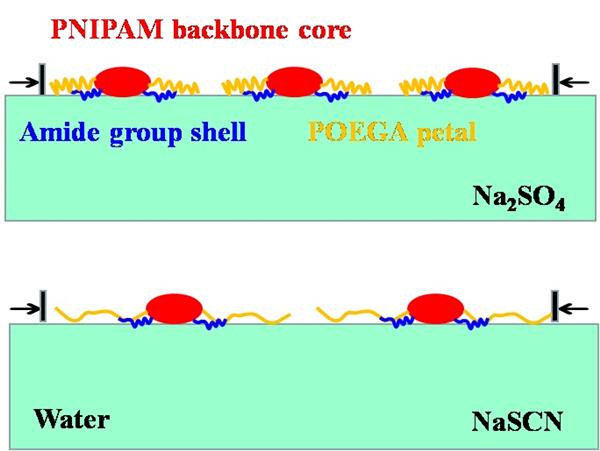33.【J. Appl. Polym. Sci.】Ionic strength and anion-specificity effects on the interfacial behavior of double hydrophilic block copolymer PNIPAM-b-POEGA
writer:Wenting Pan, Gangyao Wen,* Despoina Giaouzi, Stergios Pispas, Hongxu Chen
keywords:LB film, Langmuir monolayer, double hydrophilic block copolymer, ionic strength, anion-specificity
source:期刊
specific source:J. Appl. Polym. Sci. 2024, e55462.
Issue time:2024年
In our prior paper, surface micelles with the core-shell-petal structure of the double hydrophilic block copolymer poly(N-isopropylacrylamide)-block-poly[oligo(ethylene glycol) acrylate] (PNIPAM-b-POEGA) were successfully evaluated. In this work, ionic strength (under acidic conditions) and anion-specificity effects (under neutral conditions) on the aggregation behavior of PNIPAM-b-POEGA at the air/water interface and the morphologies of its Langmuir-Blodgett (LB) films were systematically studied. Under acidic conditions, salting-out effect prevails to electrostatic shielding effect, and the amide group shells with slight protonation degree are covered up by the large POEGA petals. Under neutral conditions, the stretching degrees of POEGA blocks at low/moderate salt concentrations are close. At high salt concentration, the isotherms gradually shift to large molecular area in the order of the NaCl, Na2SO4, NaNO3, and NaSCN cases. The hysteresis degrees of the monolayers increase with the increase of salt concentrations due to the gradually increased interfacial stretching degree and compression-induced underwater solubility of POEGA blocks. All the initial LB films of PNIPAM-b-POEGA exhibit isolated circular micelles with small cores. Upon compression, the LB films exhibit slightly large micelles because of the possible coalescence of some neighboring cores.

Article address: http://doi.org/10.1002/app.55462
Read-only address: https://onlinelibrary.wiley.com/share/author/TSTCF7SUVHXVQBFUATV3?target=10.1002/app.55462